One of the sub-themes of Riders to The Sea is the struggle
for power between the old religions such as the cult of Odin, the Druids, and worship of various dieties of the Celts and
Vikings, with the new religion Christianity.
The pagan religions usually timed their festivals to coincide with
the agrarian year or the times of equinox and solstice.
Many of the old harvest customs have probably been lost through time. Some features of the old
customs still remain, but the origins of how they started are forgotten by most people. However, research can uncover many
interesting facts about the remnants of these customs.
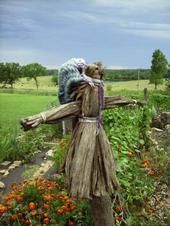
|
| Corn Dolly, also called Queen Sheaf of the Harvest |

|
| corn dolly in winter |
The last sheaf, or last load of the crop is designated the Harvest Queen
Corn dolly or corn baby was one of many names
given to a figure woven from the straw after the grain was gleaned at the end of the harvest season.
Even today, these ancient harvest customs are reflected in designs for
wreaths and swags to decorate autumn tables, as in the case of this Wheatsheaf Spiral.
| The Wheatsheaf Spiral |
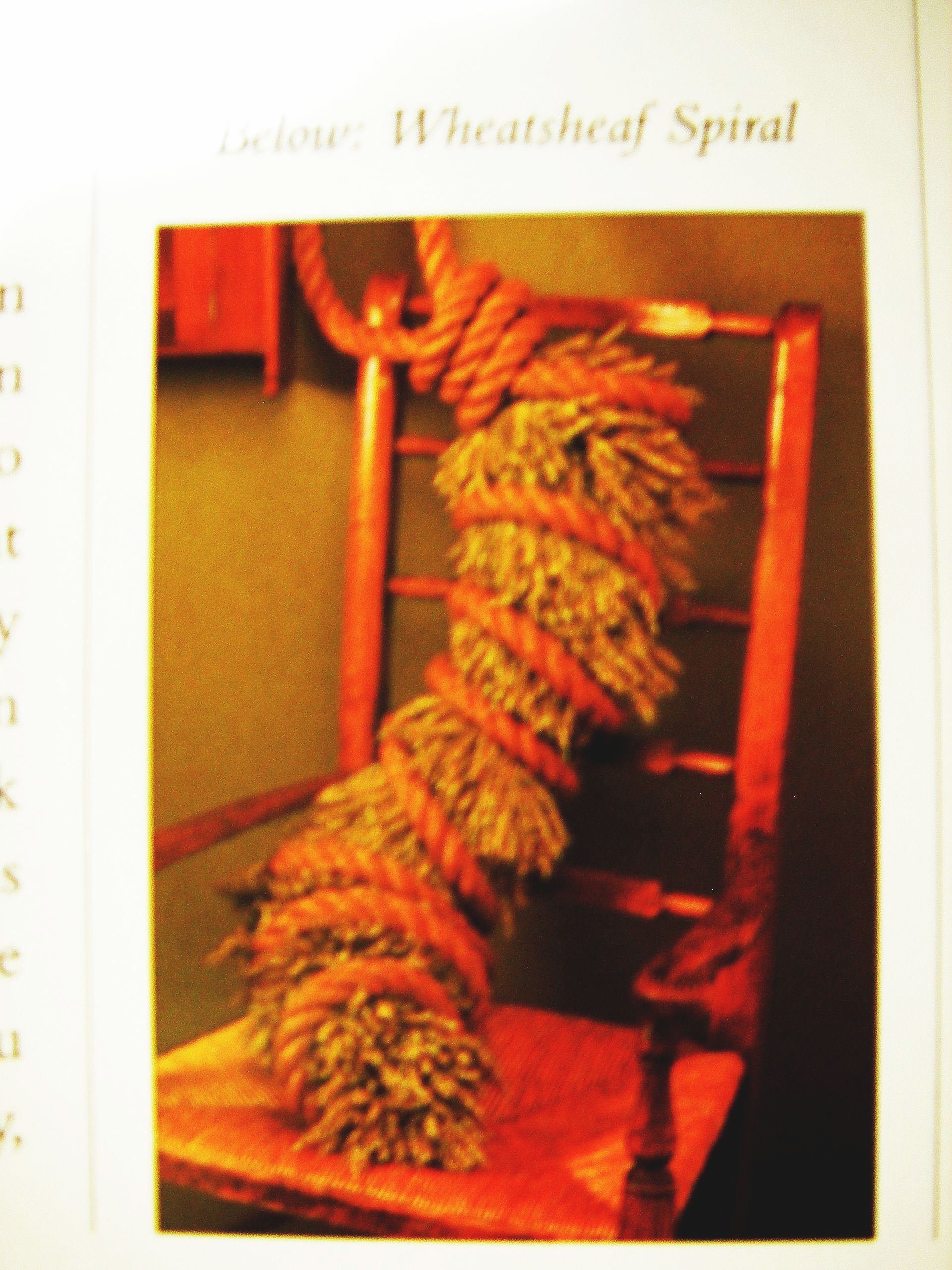
|
| from Complete Book of Garlands, Circles & Decorative Wreaths by Fiona Barnett |
The Spiral Dance at Beltane
In modern times, people associate wreaths with fall and winter celebrations.
Most do not know the origin of making wreaths to decorate the home during the holidays.
Scotsman Robert Wilson, dedicating his Poems
Chiefly In The Scottish Dialect, began with these two lines indicating the wreath expressed warm wishes:
"&IR, wi' this simple rustic wreath,
My warmest wishes I bequeath"
Wreaths were symbols that conveyed a message. In modern times, wreaths are put on
graves to express grief and sympathy for the surviving family. Christmas wreaths express the festive nature of the season.
Some people use wreaths in a decorative way in their homes without having any special symbolic meaning in mind.
One of the reasons that pagan customs were disguised was the fact that
the believers in paganism and the believers of Christianity hated the practices and beliefs of the other, often manifesting
their opposition in violent ways. During the Crusades, Christains of the time fought Muslims for ownership od the Holy Land.
An example of this was found in the story of a Cornish king named Teudor
(Tewdrig) who..."appears in the Cornish Bewnans Mariasek (Life of St Meryadoc) as a Muslim!..we are told that Teudor
'fearing lest they might convert his people to the faith of Christ' puts Gwinear, Piala, and some of their companions to death...It
has been argued, by Henry Jenner among others, that Teudor was probably just 'a slack Christian'; he was certainly not a Muslim.
However, there is an obvious alternative, that Teudor was not only a king but a Druid and defender of the old faith" (Ellis,
88-89).
Eventually, Christianity prevailed and paganism was forced "underground".
The play Riders to The Sea discusses the pagan festival of
Samhain that came after the harvest festivals:
"Maurya (raising her head and speaking as if she did not see
the people around her). They're all gone now, and there isn't anything more the sea can do to me. ...I'll have no call
now to be up crying and praying when the wind breaks from the south, and you can hear the surf is in the east, and the surf
is in the west, making a great stir with the two noises, and they hitting one on the other. I'll have no call now to be going
down and getting Holy Water in the dark nights after Samhain, and I won't care what way the sea is when the other women will
be keening. (To Nora.) Give me the Holy Water, Nora, there's a small sup still on the dresser.
[Nora gives it to her.]
"MAURYA (drops Michael's clothes across Bartley's feet, and sprinkles the Holy Water over him).
It isn't that I haven't prayed for you, Bartley, to the Almighty God. It isn't that I haven't said prayers in the dark night
till you wouldn't know what I'ld be saying; but it's a great rest I'll have now, and it's time surely. It's a great rest I'll
have now, and great sleeping in the long nights after Samhain, if it's only a bit of wet flour we do have to eat, and maybe
a fish that would be stinking." Maurya is not particularly happy about the new religion since the young priest has told
her that God would not let her be totally without a son to support her, and now the last male in the family is dead. She has
prayed the Christian prayers for Bartley, but in vain. Perhaps her mention of a stinking fish is a bitter comment about
the new religion since the fish was a very early symbol of the Christian religion.
Samhain
was a time when the dead were believed to be released from their graves and allowed to roam the world of the living. Throughout
Europe,
there are many customs and beliefs that the dead could be called up again, that there was life and activity in the abode of
the dead, and that the dead required the care and attention of the living.
The
passage in death of a chieftain or warrior to another world after was shown in the Norse belief in “nisse”
"The belief in the 'nisse' also goes back to pagan times. ... as protector of the
farm can be traced back to the man who, some time during the distant past, had first cleared the land. Often this man was
believed to be buried in one of the burial mounds near the houses. At Yuletide, the feast for the dead, food and drink was
brought out to the mound for him, and he was believed to come out to eat and drink. During the centuries the popular image
of this much respected and feared ghost changed into the less dangerous, but still at times destructive and leprechaun-like
'nisse' of Norwegian fairy tales..." (http://www.cyberclip.com/Katrine/NorwayInfo/Articles/Christmas.html).
Samhain was associated with a deep and death-like sleep. During Samhain,
pagans thought the dead could visit their old homes by passing through an invisible portal into the world of
the living, through a barrier like the threshold of a door.
Samhain was a winter festival. The earth was thought of as being asleep in death,
waiting to be reborn when spring caused the new growth of vegetation. In Riders to The Sea, Maurya, although a Christian,
remembers this festival.
There are religious themes underlying all of this, such as the hope of rebirth and
resurrection.
Whether Christian or pagan, people of the Irish island of Aran needed to bolster their belief that there was some kind of future hope in their hard
lives. Many people were reluctant to completely let go of their pagan beliefs. The mere mention of Samhain was enough
to call to mind all of the associations of the otherworld or afterlife, thus offering a spiritual tone of the old religion,
albeit barbaric. Celtic Myths by Miranda Jane Green offers this insight as to the delicate balance supposed to be in
the world:
"The somber aspect of the Otherworld is equally
represented in myth. Samhain, at the beginning of November, was considered a dangerous time, a kind of limbo where
the barriers between the real and supernatural worlds are temporarily dissolved and where humans and spirits can penetrate
each other's space, thus upsetting the normal balance " (Green, 74).
Apparently, normal balance was affected by these superstitious beliefs. Samhain was a time of fear for many, because dealing
with spirits of the dead was not part of their normal lives, and because people often feared what these spirits might do to
them.
The fact that Samhain is mentioned in the play shows
that this old festival still existed in the memories of the many of the Irish. There is every reason to think that the Irish
audience of Synge's day would be familiar with the reference to Samhain.
There are also implications of other pagan
practices connected to this third and final harvest festival. The Standard
Dictionary of Folklore, Mythology and Legend, edited by Maria Leech, adds further to our understanding:
"Many cultures had similar elements that brought mystery
and fear to the unknown times closely associated with religious festivals, both pagan and Christian. They were woven
together in a piece of whole cloth. In the Orkney Islands, elements similar to Norse, Scots and Irish myths appeared"
(Leach).
Because of the highly charged spiritual atmosphere associated with Samhain,
people would use this occasion to try to find out about events for the coming year. The Druids discusses
this, saying:
"Fingin Mac Luchta of Munster in Ireland who, on every feast of Samhain,
would visit a similar Druidess who was able to relate all the occurrences in the kingdom on that night and the results which
would issue from them during the next twelve months" (Ellis, 96-97).
These oracles of Samhain were essentially the same as volvas, seeresses, witches,
and female prophets.
The Old English word for
cup is bune. Buan means to dwell, settle, or cultivate. In times past, the husband of the household would
be the head of the family.
Finding out how these words might be related linguisticly is a deep and
difficult undertaking, but toward the end of Riders to The Sea, there is a cup mentioned. It has been established
that there is no living husband.
'Maurya sprinkles Michael's clothes with the last of the Holy Water and puts the empty cup downwards on the table, no longer
needed."
Another seemingly related word from Old English is buan.
It is connected to the idea of the husband of the house, the Lord and Master, as it were.
"Webster's gives the etymology of husband::
"Middle English husbonde,
from Old English hūsbonda master of a house, from Old Norse hūsbōndi,
from hūs house + bōndi
householder; akin to Old Norse būa to inhabit; akin to Old English būan to dwell - more at bower" (http://www.merriam-webster.com/dictionary/husband).
One linguist gives this opinion:
"Webster's gives the etymology of husband:
Etymology: Middle English husbonde, from Old English husbonda master of a house, from
Old Norse husbOndi, from hus house + bOndi householder; akin to Old Norse bua to inhabit; akin
to Old English buan to dwell."
The Saxon word for bun is boun. It was derived from the word for a sacred
ox that was slaughtered and eaten. Even though meat and bread are entirely different, in olden times grain was considered
to be slaughtered when it was cut from the chaff.
Easter, in pagan times, was a time to slaughter the sacred
ox. In modern times, it is a time for hot cross buns in some parts of the world. The origin of this custom is pre-Christian:
"At
the feast to Eastre, an ox was sacrificed and the image of his horns carved into ritual bread - which evolved into the twice-scored
Easter biscuits we call 'hot cross buns.' In fact, the word 'bun' derives from the Saxon for 'sacred ox,' 'boun.'" A cross bun kept from one Good Friday to the next was thought to bring luck, the buns were supposed to serve as
a charm against shipwreck, and hanging a bun over the chimneypiece ensured that all bread baked there would be perfect. Another
belief was that eating hot cross buns on Good Friday served to protect the home"
(http://wiki.answers.com/Q/Where_did_hot_cross_buns_originate).
The Babylonians offered buns inscribed with a solar cross.
The English word belle, although from a similar word origin
in French, had an entirely different meaning. The Norman French in England set a curfew for the conquered Anglo-Saxons,
which curfew was signaled by a bell. In the Anglo-Saxon dialect, bell meant "to roar", and the tolling of the curfew
bell was to them an unpleasant roar. Thus, the bell bellered, as does a bull or an ox.
Middle English and the Latin bellum
produced the word bellicose, meaning quarrelsome or warlike.
English Roots and the Derivation of Words from the Ancient Anglo-Saxon by Edward Newenham Hoare
Definition of Bellicose
The word Easter is derived from the name of the Saxon
goddess of the Spring Equinox, Eostre. She was thought to preside over a festival of uninhibited joy and sexuality.
Easter, Saxon Goddess of the Spring Equinox
Saxon Sacred Ox Horns and the Origin of Hot Cross Buns
The Boon, A Cake With Horns
The folk of old spent a great deal of time making sure that
the world kept going on with them maintaining fertile crops, large families, and themes of rejuvenation. These themes
from the "beginning of time" carried over into Christian times in the form of Easter symbols such as the rabbit and egg, ancient
symbols of fertility. The egg, in particular, has had its symbolism changed to that of the stone that was rolled away from
Jesus' tomb; thus the children's egg rolling at Easter time. In the Pace Egg Plays, there is reenactment of good versus evil, old and new, and pagan versus
Christian. A hero archetype slays the villain or various villains in the Pace Egg Plays. The plays are very popular in their locales,
and some have been performed since before WW1. Undoubtedly, these plays are actually hundreds of years old.
The Pace Egg Plays are traditional village plays, with a rebirth theme, in which ... word 'Pace' comes from the old English
word 'pasch' literally meaning 'Easter'.
Sir Walter Scott writes: "On Hallowmas Eve, ere ye boune to rest" in St. Swithin's Chair.
St. Swithin was a real saint, but Sir Walter Scott's poem is about paganism.
The person who sat in St. Swithin's (saints within?) chair was compelled to answer questions put to them, and the formula
for the session was based on pagan symbolism. "The Lady" who sits in the chair is a witch who rides in the sky with nine other
witches. The questioner forces her down from her ride, and for this reason, she is under his power and must answer his questions.
This model is similar to the one where Odin causes a Valkyrie to rise from the dead.
She must answer the questions he asks of her. These questions require the power of divination.
St. Swithin/Swithun
St. Swithun and Egbert
Samhain Night
The idea of symmetry
and balance, like the image of Justice, is also included in this context, making the two dimensions or worlds poised
in delicate balance and aligned with one another, separated, it was supposed, by a veil that was dangerously permeable
during the Eve of Samhain.
According
to legend, it was during this time that the spirits of the dead were free to roam, often returning to their former homes.
This was considered a very dangerous time for mortal folks.
The end of summer was marked by shorter days and loss of warmth from the sun. The
hearth was often the center of family life during ancient times. It was the place
where food was given as well as warmth from the fire and family fellowship.
In The Golden Bough, it says:
"Not only among the Celts but throughout Europe,
Halloween was the night which marks the transition...when the souls of the departed were supposed to revisit their old homes
in order to warm themselves by the fire" (Frazer, 220).
Symmetry and balance between this world and the otherworld
can be typified by the threshold of the cottage where Maurya lives in Riders to the Sea.
The idea of the threshold of the house being a special
open portal is seen in the custom of the groom carrying the bride safely over it . The Roman god Janus was the god or
guardian of doorways.
In Man, Myth & Magic, it says this
about thresholds:
"Arnold van Gennep pointed out, in the Rites of Passage,
that the key to much magical and religious reverence, not merely for the threshold which must not be profaned by treading
on it, but for the whole doorway, is the idea of passing through a door or gate or portal of any kind as a transition from
one realm or condition to another."
The door is the boundary between the foreign and domestic
worlds, in the case of a person's dwelling and between the common and the sacred.
When the women cross the threshold of the cottage,
they see Maurya's dead son, shoeless, on the table.
Both feet and shoes are replete with
symbolism.
The book The Word Museum
tells us that an archaic usage of dead men's shoes means "To wait for dead men's shoes, to wait for a
place till it becomes vacant by the death of the present possessor. This corresponds with the adage, 'He goes long barefoot
that wears dead men's shoes,' spoken to them who expect to be some man's heir, to get his place, or his wife, if he
should die [Jamieson] (Kacirk, 56).
Myths reflect our cultural and psychological souls.
The gods and goddesses, fairies, elves, gnomes, giants, and various otherworldly people tell a world of things about the people
who keep them alive in memory.
In The Forgotten Language, it says:
"If one fails to grasp the true meaning
of the myth, one finds oneself confronted with this alternative: either the myth is a prescientific, naive picture of the
world and of history and at best a product of poetically beautiful imagination, or- and this is the attitude of the orthodox
believer- the manifest story of the myth is true, and one must believe it as a correct report of events which actually happened
in 'reality'".
Generally, the myth is seen in symbolic terms by educated people in the 21st century.
Leech discusses
the fairies in The Standard Dictionary of Folklore, Mythology and Legend:
"One of the oldest Irish sagas states
that the barrows where the fairies dwelt were open about Samhain... According to Keating, in heathen times the druids on Ireland
assembled to sacrifice to the gods and burn their victims on Samhain Eve. All other fires were extinguished to be rekindled
only from that fire" (Fromm, 968).
In this statement, there are all the elements of the hill barrow or fairy
mound where an underground world is said to flourish. Samhain or Halloween was the time when the gates between two worlds
were open, and the living human and the Otherworld folk, including the dead, could pass freely.
In the account of the Viking burial, the dead chieftain
is buried for a time, but he is exhumed at a later time.
In older cultures, during the Wake, the dead body
was often treated as if the person were alive. Sometimes the corpse was set up to a table in a chair, spoken to, and danced
with the living before being buried. All these are expressions of culture show views that this present life is only one before
another life in another dimension or realm.
Many of the pagan customs involved lighting fires and passing people and
cattle through a bonfire. These fires were often lit during the nights when spirits were said to pass into this world.
They provided light in the darkness, and so, were also seen as a protecting influence.
If you consider the extinguished
life fires in Maurya's household, you can also see the need for a new fire to be lit on the hearth. This could furnish one
interpretation of the bundle the two daughters are hiding in the loft.
These ancient customs, some seeming to be near
duplications of passing children through the fire to Molech in spirit have been watered down through time. Instead of burning
the children alive in the fires, the custom evolved of merely running through the fires. Still, at one time, human and animal
sacrifice were offered.
In Celtic Myths it is told that "...one Irish tradition involved the triple
killing of a king, by burning, wounding and drowning, at the feast of Samhain" (Green, 69).
Bonfires were associated with witches and St, John's Eve around the time
of the Summer Solstice. In the United Kingdom, three kinds of bonfires were made:
"Mirk adds that at the time of his writing, "...in worship of St John
the Baptist, men stay up at night and make three kinds of fires: one is of clean bones and no wood and is called a " bonnefyre";
another is of clean wood and no bones, and is called a wakfyre, because men stay awake by it all night; and the
third is made of both bones and wood and is called, "St. John's fire" (Festial 182)." These traditions largely ended after
the Reformation, but persisted in rural areas up until the nineteenth century before petering out"
In
Riders to The Sea,the life fires of Maurya's
household have been extinguished. Their hope for the future might seem to have been extinguished, but the question of
the bundle arises. Although its first meaning is a literal bundle of clothes, the phrase bundle of joy comes
to mind. If one of Maurya's two daughters, like the Biblical Naomi with her two daughters-in-law, should marry and provide
a new husband and heir, their future hope could be rekindled with new providers.
There is also the idea of sacrifice. Though, perhaps, underplayed, the thought is
there, as we have seen in the loss of men in Maurya's family and from historical reference. In Celtic Myths, this
thought ties the cult of Odin to Samhain:
"...one
Irish tradition involved the triple killing of a king, by burning, wounding and drowning, at the feast of Samhain" (Green,
69).
The Burning of Men and Animals in the Fires
There is
a motif called the Thracian Rider God, a somewhat mysterious figure.
"There are
a few deductions which can be made about the significance of this mysterious figure. First, it must be noted that the figures
of a horse and rider frequently occur on classical Greek and Etruscan funerary monuments. Such representations had a mortuary
significance - the deceased was departing from this world to the next."
Here the
mystery of his identity becomes more puzzling...The name most frequently given is 'Heros' or 'Heron'. This could be the designation
of a dead man..."Man, Myth & Magic, The Illustrated Encyclopedia of Mythology, Religion and the Unknown, Volume
19, 2610).
Hobby Horse Mayday Festival, Cornwall
Odin's
horse, Sleipnir, is suggestive of funerary imagery: its eight legs are thought to represent four men (two legs apiece) carrying
a corpse. Whether under the name of Grim or Wotan, when led by the gallows god, the Hunt becomes a terrifying, roving memorial
of the ancient dead and the physical routes they have taken to and from their graves."
The horse as an element
and symbol appears in both a literal and symbolic sense and linked to various other cultic symbols and practices. Always valued by man for its proverbial horse-sense and for its usefulness, the animal was also worshipped
as a deity at times and used to play out mystical dramas. The Gaulish Celts worshipped
the Mare Goddess, appearing in other cultures as Epona and associated with The Three Epona and the Triple Goddesses. One cultic
practice in twelfth century Ireland
involved a local king acting out a re-birth in a white mare ceremony. Afterward,
the mare was slaughtered and eaten. We read of the culmination of the ceremony
by the king:
"He stood on an inauguration stone and received a straight white wand, which he held while turning three times left
and three times right in honor of the trinity" (The Encyclopedia of Witches and Witchcraft, 165).
Since Maurya's sons are seen horseback riding together, a literal reading
of the ghostly ride isn't likely. The legendary elements of the Wild Hunt, The Green Man and Herne the Hunter are typified
by these riders. Their furious ride suggests the legendary wild hunt. The brothers
could be chasing after the goddess-bride, the prize of the original wild hunt. The following link informs us that:
"In the Scandinavian countries of
Norway,
Sweden, and Denmark the Hunt was most often named after its leader, Odin. It was called Odensjakt (Odin's
Hunt), Oskerei (Horrific or Thunderous Ride), the Gandreid (Ride of the Dead), and the Asgardreia (Ride of Asgard). This Norse
version of the Hunt was often seen chasing a beautiful Otherworldly maiden perhaps a memory of grim night chases conducted
by invading armies."
These legends might
be frightening because, originally, the prey were human beings.
In France
we find the Hunt under the name of "The Family of the Harlequin." Two theories persist on the origin of this name. One (by
Guerber) states that another form of the name "Mesnee d' Hellequin" is a derivative of the name for the Norse Goddess/Giantess
of death, Hel.
In Germany
where many tales of the Hunt have survived and are still being re-enacted today, the Hunt is commonly associated with Odin
and called Wotan's Hunt. Other names were Wotan's Army, the Wilde Hunt."
The Wild Hunt
Herne, The Hunter in Windsor Forest
They all will have one more joke at Falstaff's expense: he is to dress up with horns on his head like Herne the Hunter.
The archetypical themes of the wild hunt were so ingrained on people's
minds that many churches were adorned with stone carvings depicitng pagan, not Christian, themes. One such church, St. Mary
and St. David of Kilpeck, Hereford, and Worcester, England is:
"Considered to be one of the finest remaining examples of the late Romanesque
style...If any one feature of this remarkable church has to be singled out it must surely be the south doorway. The two arches
over the door are filled with a strange collection of animals, birds and other creatures...More than twenty grotesque carvings
form the corbel table that runs around the outside of the church. Many are human heads, horribly haunting, others are symbols
of the chase, such as falcons, wild boar and deer" (Brabbs, 20).
St. Mary and St. David church
Corbels (diminutive of corvus, a raven) and Kilpeck
Kilpeck shows pagan Viking and Green Man motifs
Another example of plentiful wildlife for the hunt and possibly a jester
theme is found at St. Nicholas church, Barfreston, Kent, England:
"The south doorway could be compared to the similar example at Kilpeck
in Hereford. Careful scrutiny will reveal strange images: Samson opening a lion's jaws; a bear playing a harp; a monkey with
a rabbit over its shoulder riding a goat, and many more" (Brabbs, 27).
Corbels from St. Nicholas, Barfreston, Kent (photos)
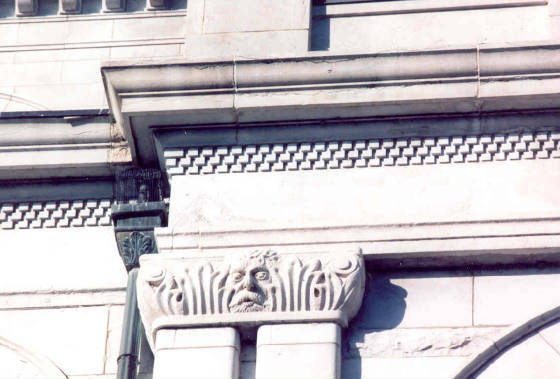
|
| Green Man Motif, Courthouse, Jefferson City, MO |
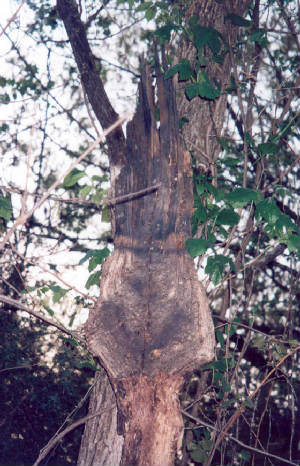
|
| "Bunny Man" hidden in the trees |
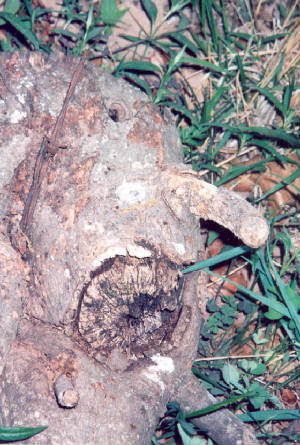
|
| A "Wood Man" |
The Druids left many beliefs among people:
"The belief that passing children through the hole of Men-an-Tole would
cure them of rickets could be a superstition of the Druids...(Ellis, 89).
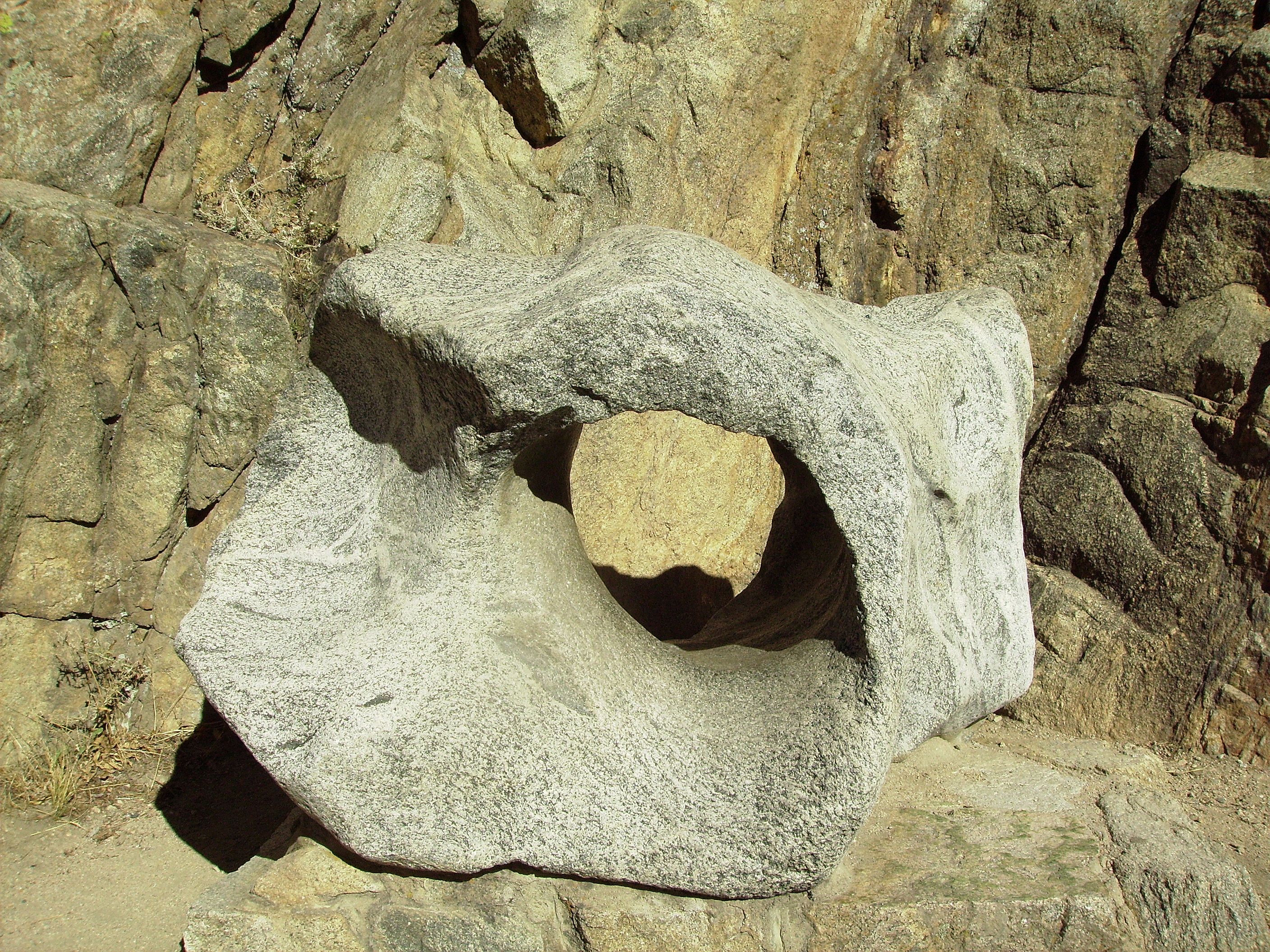
|
| Logan Stone at Boulder Falls, CO |
St. Mary's Church, Woolpit, located east of
Bury St. Edmunds gets its name, not from wool, but from wolves (Timpson, 94).
"Woolpit, or Wlfpeta, is said to derive its name
from the deep ditches which were dug to trap wolves" (http://www.onesuffolk.co.uk/Villageofthemonth/Woolpit.htm).
At some point in time, the "Green Children
emerged from their subterranean world, attracted by the sound of church bells...and they spoke a strange tongue" (Timpson,
94).
It is not impossible that the children were purposefully trapped in the
wolf pits.
Figure from St. Mary's Woolpit, Suffolk
Deep pits, perhapa conceived as entrances to the Otherworld, were filled
with offerings of jewels, pottery and weapons which had been ceremonially broken before being thrown in..." (Fleming, 42).
It may be that the actual truth, forgotten from time long ago, was that
the Green Children, gently remembered as coming out of the cemetery, had actually been thrown into the pit as ceremonial offerings.
From "A Child's Christmas In Wales" by Dylan Thomas:
"Years and years ago, when I was a boy, and there wolves in Wales,
and birds the color of red flannel petticoats whisked past the harp-shaped hills.."
A Child's Christmas In Wales
Figure E, A Green Man's head with horns
Are Grimms Fairy Tales too twisted for children?
In the church of
St. Mary's, Hasppisburg, England, a church dedicated to shipwrecked mariners, there is a font with "club-wielding wodehouses,
traditional wild men" (Timpson, 64).
The top of
the font resembles the canopy of a tree, while the base becomes cylindrical with the lowest segment containing the carvings
of the wild men alternating with carved lions.
Wodehouses
are wild men from the woods. They might be linked to the tales of Robin Hood and his band of Merry Men who lived and hid in
Sherwood Forest.
Since one
of Odin's names was Woden, could the wild men be the bodily houses containing Odin's battle fury, making themselves Woden's
vessels? When in a battle rage, they might have fought like the Berserkers or "Bear Shirt" warriors.
Ancient fables of other cultures
impart more meaning about the symbolic nature and relationship of horses to ancient people.
The Lost Language of Symbolism by Harold Bayley states:
"The one-eyed Arimaspians, everlastingly
on the prowl for the treasured gold of the Hyperborean Griffins rode, it is said, on horses, an implication that they were
men of intellect." (286).
The two eyes, as have been exemplified,
typified, respectively, Knowledge and Love, and one may reasonably deduct from the very marked mention of horses, that the
solitary eye possessed by the Arimaspians was the Eye of Intellect, and that the missing eye was the Eye of Love.
Any
history of "one-eyed" people might cast light on the story of Odin. "In the land of
the blind, the one-eyed man is king."
In Greek myth, the one-eyed Arimaspians were relentlessly on the prowl for the treasured gold of
the Griffins. They were said to have the heads of dogs. This could make us think of the constellations and Canis Major and Minor.
The seafaring people of Aran
would have to know a lot about the stars to navigate the ocean.
Arimasp means One-Eyed in the Scythian
language. Arim- certainly sounds a lot like Aran, but we can only guess if Synge had this in mind.
Maurya
saw, perhaps with "the eye of love", her two sons riding in the distance. In some cases, riding on horses indicated an elite
status.
Hyperborean Griffins rode on horses, suggesting that they were men of intellect.
According to ancient
writings, the two eyes typified knowledge and love, and one may reasonably infer from the mention of horses that the solitary
eye possessed by the Arimaspians was the Eye of Intellect, and the eye that was lacking was the Eye of Love.
The story
of one-eyed Odin and how he gained his magical knowledge by the loss of that eye, might have left him hardened to adversity
by the experience, thereby losing the Eye of Love.
Knowledge is often tempered by Love and reports a complete story,
just as Odin's two ravens whispered into each of his ears. Since there was one on each side, probably what he heard was not
"in one ear and out the other".
A colplete view is composed from literature, mythology and legend, and one sees a bigger picture. Synge, as an inhabitant of the modern world, returned to the past by way of his
education on the Aran Islands. This ancient past, encompassing many different
groups of people, was pieced together in ancient times. His friends at the
Abbey Theater certainly shared an interest in the historical legends and literature of their country and in preserving that
heritage.
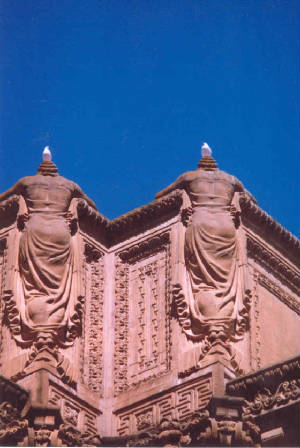
|
| San Francisco Palace of Fine Arts |
Critical Essay: Riders To The Sea, 1
Riders to The Sea, 2
Riders to The Sea, 3
Ghost House, Ghost Town, The Orchard
Riders to The Sea, Odin
Give Us This Day Our Daily Bread
Barns
Riders To The Sea, Linguistic Implications

Riders To The Sea: The Play
Bibliography
Anderson, William.The
Green Man, The Archetype of Our Oneness With the Earth. San Francisco: HarperCollins, 1990
Brabbs, Derry. English Country
Churches. New York: Viking Penguin, Inc., 1985
Bouchard,
Constance Brittain. Knights In History And Legend. New York: Firefly Books (U.S.) Inc., 2009
Brooks, Laura. Windmills. New York: Friedman/Fairfax Publishers, 2000
Campbell, Joseph. Portable Jung. New York: Penguin Books, 1988
Campbell, Joseph. The Masks of the Gods: Occidental Mythology. New York: Penguin Books,
1976
Campbell, Joseph. The Mythic Image. Princeton: Princeton University Press, 1974
Caudill, Rebecca. My Appalachia. New York: Holt, Rinehart, and Winston, 1966
Cavendish, Richard. Encyclopedia of the Unexplained, Magic, Occultism and Parapsychology. New York: McGraw
Hill, 1974
Cavendish,
Richard. Man, Myth & Magic, The Illustrated Encyclopedia of Mythology,
Religion and the Unknown. North Bellmore: Marshall Cavendish Corporation, 1995
Christiansen, Eric. The Norsemen in the Viking Age. Oxford: Blackwell Publishers, Ltd., 2002
Coolidge, Olivia. Legends of the North. Boston: Houghton Mifflin Company, 1951
Cotterell, Arthur. Macmillan Illustrated Encyclopedia of Myths and Legends. London: Marshall Editions Limited,
1989
Darling,
David. Teleportation, The Impossible Leap. Hoboken: John Wiley & Sons, Inc., 2005
Dersin,
Denise. What Life Was Like When Longships Sailed. Richmond: Time-Life Books, 1998
Diamond, Robert. Old English, Grammar and Reader. Detroit: Wayne State University Press, 1970
Dumezil, Georges. Les Dieux des Germains. Los Angeles: Center For The Study Of Comparative Folklore and Mythology,
1973
Dumezil, George. The Destiny of the Warrior. Chicago: University of Chicago Press, 1969
Dyk, Walter. Son of Old Man Hat. Lincoln: University of Nebraska Press, 1938
Eliade, Mircea. The Encyclopedia of Religion, Volume II. New York: Macmillan Publishing Company, 1987
Ellis, Peter Berresford. The Druids. London: Wm. B. Eerdmans Publishing Co., 1995
Favazza, Armando. Bodies Under Siege - Self-Mutilation and Body Modification in Culture and Psychiatry, Second Edition. Baltimore:
Johns-Hopkins University Press, 1996
Fleming, Fergus. Heroes Of The Dawn: Celtic Myth. London: Duncan Baird Publishers, 1996
Frazier, Sir James. The Illustrated Golden Bough. London: George Rainbird Limited, 1978
Fromm, Erich. The Forgotten Language. New York: Grove Press, 1951
Gerstenberger, Donna. John Millington Synge. Twayne Publishers: University of Washington, 1964
Grant, Michael and John Hazel. Gods and Myths In Classical Mythology. Springfield: C & G Merriam Company,
1979
Green, Miranda Jane. Celtic Myths. Austin: University of Texas Press, 1993
Grof, Stanislov. The Holotropic Mind. New York: Harper San Francisco, 1992
Guilley, Rosemary Ellen. The Encyclopedia of Ghost and Spirits, New York: Facts On File, Inc., 1992
Guilley, Rosemary Ellen. The Encyclopedia of Witches and Witchcraft. New York: Facts On File, Inc., 1989
Hamlyn, Paul. Scandinavian Mythology. London: Hamlyn Publishing Group, 1969
Haywood, John. The Penguin Historical Atlas of the Vikings. New York: Penguin Books USA Inc., 1995
Hissey, James John. The Charm of the Road. London: Macmillan and Co., Limited, 1910
Hull, R.F.C. and Joseph Campbell. The Portable Jung. New York: Penguin Books, 1972
Jashemski, Wilhelmina F. The Gardens of Pompeii, Herculaneum and the Villas Destroyed by Vesuvius. New Rochelle:
Caratzaz Brothers, 1979
Jobes, Gertrude. Dictionary
of Mythology, Folklore and Symbols. New York: The Scarecrow Press, Inc., 1937
Jordan, Michael. Witches,
An Encyclopedia of Paganism and Magic. London: Kyle Cathie Limited, 1996
Kacirk, Jeffrey. The Word Museum. New York; Simon & Schuster, 2000
Leach, Maria. Standard Dictionary of Folklore, Mythology and Legend. New York: Harper and Row Inc., 1984
Leach, Maurice. Standard Dictionary of Folklore, Mythology and Legend. New York: Funk & Wagnalls, 1978
Lecouteux,
Claude. Dictionary of Ancient Magic Words and Spells from Abraxas to Zoar. Inner Traditions: Rochester, 2014
Livio, Mario. The Equation That Couldn't Be Solved. Simon & Schuster. New York, 2005
Livingston, Charles. Knot Theory. Washington DC: Mathematical Association of America, 1993
Longgood,
William The Queen Must Die And Other Affairs of Bees and Men. New York: W.W. Norton and CO, 1985
Lunde, Paul. The Book of Codes, Understanding
the World of Hidden Messages. Berkely: University of California Press, 2009
Matthews,
John. King Arthur And The Grail Quest. London: Blandford, 1994
Matthews, John. King
Arthur, Dark Age Warrior and Mythic Hero. New York: Carlton Publishing Group, 2004
Matthews,
John. Le Morte De Arthur by Sir Thomas Mallory. London: Cassell Cassell & Co., 2000
May, Rollo.
The Courage To Create. New York: Bantam Books, 1976
McCourt,
Malachy. Danny Boy. Philadelphia: Running Press Book Publishers, 2002
Munch, Peter Andreas. Norse Mythology, Legends of Gods and Heroes. New York: The American Scandinavian
Foundation, 1954
Owens, Coilin. Irish Gaelige. Washington DC: Educational Services Corp., 1986
Page, R.I. Norse Myths. Austin:University of Texas, 1990
Pennick, Nigel. Magical Alphabets. York Beach,
Maine: Samuel Weiser, Inc., 1992
Peterson, Eugene. The Message, The Bible In Contemporary Language. Colorado Springs: NavPress, 2002
Petterson, Carmen L. Maya de Guatemala, Life and Dress. Seattle: University of Washington Press, 1976
Randolph, Vance. Ozark Folk Songs. Columbia: The State Historical Society of Missouri, 1946
Reinart, Otto. Classic Through Modern Drama, An Introductory Anthology. Boston: Little, Brown and Company,
1970
Reston,
James Jr., The Last Apocalypse. New York: Doubleday, 1998
Riotte,
Louise. Carrots Love Tomatoes. Pownal: Storey Publishing, 1998
Ryan, William and Walter Pitman.
Noah's Flood. New York: Simon & Schuster, 1998
Saari, Peggy. Witchcraft in America. Detroit: The Gale Group, 2001
Szpiro, George G. The Secret Life of Numbers: 50 Easy Pieces On How Mathematicians Work and Think. Washington, DC: Joseph Henry Press, 2006
Simpson, Jaqueline. The Viking World. New York: St. Martin's Press, 1980 Stanzione, Vincent James. Rituals of Sacrifice. Walking
the Face of the Earth on the Sacred Path of the Sun. Albuquerque: First University of New Mexico Press, 2000
e
Starbird, Margaret.
The Tarot Trump and the Holy Grail. Boulder: Woven Word Press, 2000
Streeter, Michael.
Witchcraft A Secret History. Hauppauge: Barron's Educational Series, Inc., 2002
Thompson, Sue Ellen. Holiday Symbols. Detroit: Omnigraphics Inc., 1998
Thury, Eva M. Introduction To Mythology, Contemporary Approaches to Classical and World Myths. New York: Oxford
University Press, 2009
Timpson, John. Timpson's Country Churches. London: Orion Publishing Group, 1998
Van Scott, Miriam. The Encyclopedia of Hell. New York: St. Martin's Press, 1998
Waite, Arthur Edward. The Pictorial Key to the Tarot. Stamford: U.S. Games Systems, Inc., 1997
Whiteaker, Stafford. English
Countryside Needlepoint. London: Bracken Books, 1992
Wicker,
Christine. Lily Dale. New York: Harper Collins Publishers, Inc., 2003
Wilkinson,
Phillip. Illustrated Dictionary of Mythology. Chesham, Buckinghamshire: DK Publishing, 1998
Wilson,
Ian. The After Death Experience, The Physics of the Non-Physical. New York: William and Morrow Company, Inc.,
2000
Wright,
Robert. Nonzero. New York: Pantheon Books, 2000
|



